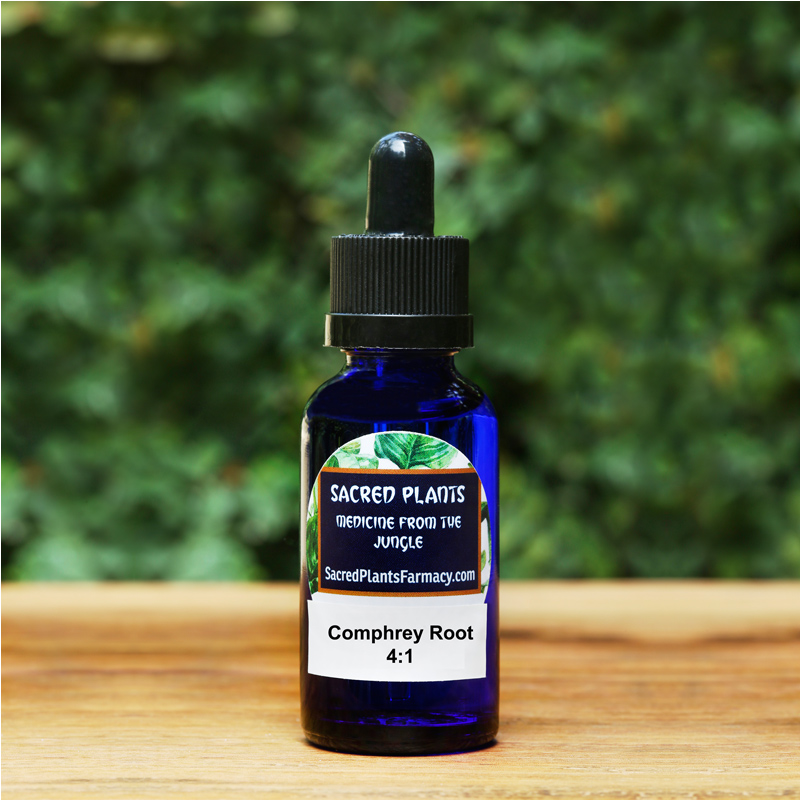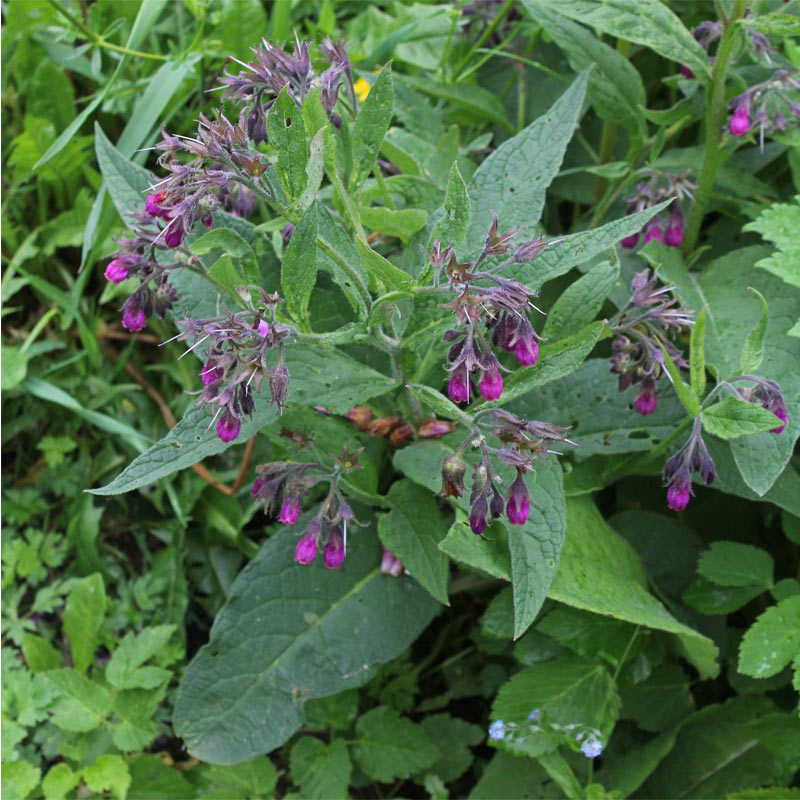Comphrey is a powerful and somewhat toxic herb that you must take care with doseage.
Despite safety concerns, comfrey is used by mouth for:
- Stomach ulcers
- Heavy menstrual periods
- Diarrhea
- Bloody urine
- Cough & bronchitis
- Cancer
- Chest pain (angina) It is also used as a gargle for gum disease and sore throat.
Comfrey is applied to the skin for:
- ulcers & wounds
- Muscle soreness & bruises
- Rheumatoid arthritis
- Varicose veins
- Gout
- Fractures.
Comfrey is a plant. Even though this plant contains poisonous chemicals called pyrrolizidine alkaloids (PAs), some people use the leaf, root, and root-like stem (rhizome) to make medicine.
Despite safety concerns, comfrey is used by mouth for stomach ulcers, heavy menstrual periods, diarrhea, bloody urine, cough, bronchitis, cancer, and chest pain (angina). It is also used as a gargle for gum disease and sore throat.
Comfrey is applied to the skin for ulcers, wounds, muscle soreness, bruises, rheumatoid arthritis, varicose veins, gout, and fractures.
How does it work?
The chemicals in comfrey might have wound healing effects and reduce inflammation when applied to the skin. However, comfrey contains toxic chemicals that can be absorbed through the skin.
Possibly Effective for
- Back pain. Applying a comfrey extract ointment to the affected area for 5 days seems to decrease lower or upper back pain. Also applying a cream containing comfrey extract plus methyl nicotinate to the affected area for 5 days seems to decrease back pain when resting or moving.
- Osteoarthritis. Applying a comfrey extract ointment to the affected area for 3 weeks or applying a specific cream containing comfrey extract, tannic acid, Aloe vera gel, eucalyptus oil, and frankincense oil to the affected are for 6-12 weeks seems to decrease pain in people with kneeosteoarthritis.
- Sprains. Early research shows that applying comfrey ointment to the affected area for up to 2 weeks improves mobility, decreases pain, and reduces tenderness and swelling of sprains. The effect of comfrey ointment in relieving pain and reducing swelling seems to be comparable to the effects of diclofenac gel.
Insufficient Evidence for
- Bruises. Early research shows that applying comfrey directly to the skin for 2 weeks might decrease the pain and tenderness of bruises.
- Abnormally heavy bleeding during menstrual periods (menorrhagia).
- Blood in the urine (hematuria).
- Cancer.
- Chest pain (angina).
- Cough.
- Diarrhea.
- Fractures.
- Gout.
- Gum disease (gingivitis).
- Hemorrhoids.
- Leg sores caused by weak blood circulation (venous leg ulcer).
- Muscle soreness.
- Rheumatoid arthritis.
- Sore throat (pharyngitis).
- Stomach ulcers.
- Swelling (inflammation) of the main airways in the lungs (bronchitis).
- Swelling (inflammation) of the stomach (gastritis).
- Tuberculosis.
- Varicose veins.
- Wound healing.
- Other conditions.
More evidence is needed to rate the effectiveness of comfrey for these uses.
It contains chemicals (pyrrolizidine alkaloids, PAs) that can cause liver damage, lung damage, and cancer. The FDA has recommended that all oral comfrey products be removed from the market.
When applied to the skin: When applied to unbroken skin in small amounts for less than 10 days, comfrey is POSSIBLY SAFE for most people. It’s important to remember that the poisonous chemicals in comfrey can pass through the skin. For this reason, it is POSSIBLY UNSAFE to apply comfrey to broken skin or to apply large amounts to the skin for more than 6 weeks.
Special Precautions & Warnings:
Pregnancy and breast-feeding: Comfrey is LIKELY UNSAFE to take by mouth or apply to the skin if you are pregnant or breast-feeding. In addition to causing liver damage and possibly cancer, the PAs in comfrey might also cause birth defects. Even topical use is unwise, since the PAs can be absorbed through the skin.
Broken or damaged skin: Don’t apply comfrey to broken or damaged skin. Doing so might expose you to large amounts of the chemicals in comfrey that can cause liver damage and other serious health effects.
Liver disease: There is a concern that comfrey might make liver disease worse. Don’t use comfrey if you have any problems with your liver.
Major Interaction
Do not take this combination!
- Medications that can harm the liver (Hepatotoxic drugs) interacts with COMFREY
Comfrey might harm the liver. Taking comfrey along with medication that might also harm the liver can increase the risk of liver damage. Do not take comfrey if you are taking a medication that can harm the liver.
Some medications that can harm the liver include acetaminophen (Tylenol and others), amiodarone (Cordarone), carbamazepine (Tegretol), isoniazid (INH), methotrexate (Rheumatrex), methyldopa (Aldomet), fluconazole (Diflucan), itraconazole (Sporanox), erythromycin (Erythrocin, Ilosone, others), phenytoin (Dilantin), lovastatin (Mevacor), pravastatin (Pravachol), simvastatin (Zocor), and many others.
Moderate Interaction
Be cautious with this combination!
- Medications that increase the breakdown of other medications by the liver (Cytochrome P450 3A4 (CYP3A4) inducers) interacts with COMFREY
Comfrey is broken down by the liver. Some chemicals that form when the liver breaks down comfrey can be harmful. Medications that cause the liver to break down comfrey might enhance the toxic effects of chemicals contained in comfrey.
Some of these medicines include carbamazepine (Tegretol), phenobarbital, phenytoin (Dilantin), rifampin, rifabutin (Mycobutin), and others.
Dosing
The following doses have been studied in scientific research:
APPLIED TO THE SKIN:
- For back pain: About 4 grams of a specific ointment containing 35% comfrey root extract has been applied three times daily for 5 days. About 4 grams of another cream containing 35% comfrey plus 1.2% methyl nicotinate has also been applied three times daily for 5 days.
- For osteoarthritis: About 2 grams of a specific ointment containing 35% comfrey root extract has been applied to the knee three times daily for 3 weeks. Also, about 3.5 grams of a specific cream containing comfrey extract, tannic acid, aloe vera gel, eucalyptus oil, and frankincense oil has been applied to the knee three times daily for 6-12 weeks.
- For sprains: About 2 grams of a specific ointment containing 35% comfrey extract has been applied to ankle sprains four times daily for 8 days.
Symphytum species belongs to the Boraginaceae family and have been used for centuries for bone breakages, sprains and rheumatism, liver problems, gastritis, ulcers, skin problems, joint pain and contusions, wounds, gout, hematomas and thrombophlebitis. Considering the innumerable potentialities of the Symphytum species and their widespread use in the world, it is extremely important to provide data compiling the available literature to identify the areas of intense research and the main gaps in order to design future studies. The present review aims at summarizing the main data on the therapeutic indications of the Symphytum species based on the current evidence, also emphasizing data on both the efficacy and adverse effects. The present review was carried out by consulting PubMed (Medline), Web of Science, Embase, Scopus, Cochrane Database, Science Direct and Google Scholar (as a search engine) databases to retrieve the most updated articles on this topic. All articles were carefully analyzed by the authors to assess their strengths and weaknesses, and to select the most useful ones for the purpose of review, prioritizing articles published from 1956 to 2018. The pharmacological effects of the Symphytum species are attributed to several chemical compounds, among them allantoin, phenolic compounds, glycopeptides, polysaccharides and some toxic pyrrolizidine alkaloids. Not less important to highlight are the risks associated with its use. In fact, there is increasing consumption of over-the-counter drugs, which when associated with conventional drugs can cause serious and even fatal adverse events. Although clinical trials sustain the folk topical application of Symphytum species in musculoskeletal and blunt injuries, with minor adverse effects, its antimicrobial potency was still poorly investigated. Further studies are needed to assess the antimicrobial spectrum of Symphytum species and to characterize the active molecules both in vitro and in vivo.
The statements made within this website have not been evaluated by the Food and Drug Administration. These statements and the products of this company are not intended to diagnose, treat, cure or prevent any disease.







